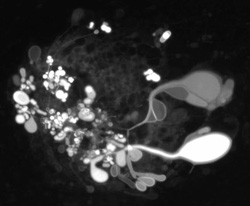Overview
We are interested in non-living things that are on the path towards life. 
Research directions
We probe the divide between living and non-living systems by building artificial cells from purified, component parts. To get the systems to behave in a somewhat predictable manner, biological parts are standardized and computationally modeled under cell-free conditions. Thus far we have built artificial cells that can sense and respond to the environment and are capable of chemically communicating with natural, living cells.
Contemporary biology is dependent upon the function of Fe-S clusters in electron transfer and catalysis. The prevalence of iron and sulfur on Earth, the ability of iron and sulfur to easily assemble into complexes, and the pervasiveness of Fe-S proteins across all Kingdoms of life has lead to the hypothesis that Fe-S complexes were among life’s first catalysts. Thus far, experimental research on the role of Fe-S clusters in the origins of life has focused on Fe-S containing minerals and specific geological settings rich in iron and sulfur, namely hydrothermal vents. However, hydrothermal vent conditions may not be well suited for many of the steps necessary for the emergence of life. We explore the potential of short peptide sequences to stabilize Fe-S clusters under prebiotically plausible conditions.
Group members
- Sheref S. Mansy, PI
- Giuliano Berloffa, PhD student
- Luca Belmonte, postdoc
- Claudia Bonfio, PhD student
- Dario Cecchi, PhD student
- Fabio Chizzolini, PhD student
- Jason Fontana, MSc student
- Michele Forlin, postdoc
- Roberta Lentini, postdoc
- Simone Scintilla, postdoc
- Omer Duhan Toparlak, PhD student
- Noel Yeh Martin, PhD student
Collaborations
We have collaborators throughout Europe and the US with the possibility for graduate students to spend time abroad in these laboratories.
Selected publications
Please see www.smansy.org for a complete list of publications with links to pdf files.
Lentini R, Perez Santero S, Chizzolini F, Cecchi D, Fontana J, Marchioretto M, Del Bianco C, Terrell JL, Spencer AC, Martini L, Forlin M, Assfalg M, Dalla Serra M, Bentley WE, Mansy SS (2014) Integrating artificial with natural cells to translate chemical messages that direct E. coli behaviour. Nature Communications, 5:4012, DOI: 10.1038/ncomms5012.
Torre P, Keating CD, Mansy SS (2014) Multiphase water-in-oil emulsion droplets for cell-free transcription-translation. Langmuir, DOI: 10.1021/la404146g.
Chizzolini F, Forlin M, Cecchi D, Mansy SS (2014) Gene position more strongly influences cell-free protein expression from operons than T7 transcriptional promoter strength. ACS Synth Biol, DOI: 10.1021/sb4000977.
Martini L, Mansy SS (2014) Measuring riboswitch activity in vitro and in artificial cells with purified transcription-translation machinery. Methods Mol Biol 1111, 153-164.
Spencer AC, Torre P, Mansy SS (2013) The encapsulation of cell-free transcription and translation machinery in vesicles for the construction of cellular mimics. J Vis Exp 80, e51304, doi:10.3791/51304.
Torino D, Martini L, Mansy SS (2013) Piecing together cell-like systems. Curr Org Chem 17, 1751-1757.
Lentini R, Forlin M, Martini L, Del Bianco C, Spencer AC, Torino D, Mansy SS (2013) Fluorescent proteins and in vitro genetic organization for cell-free synthetic biology. ACS Synth Biol 2, 482–489.
Forlin M, Lentini R, Mansy SS (2012) Cellular imitations. Curr Opin Chem Biol 16, 586-592.
Del Bianco C, Mansy SS (2012) Nonreplicating protocells. Acc Chem Res 45, 2125–2130, DOI: 10.1021/ar300097w.
Martini L, Mansy SS (2011) Cell-like Systems with Riboswitch Controlled Gene Expression. Chem Commun 47, 10734-10736.
Wu S, Bellei M, Mansy SS, Battistuzzi G, Sola M, Cowan JA (2011) Redox Chemistry of the Schizosaccharomyces pombe Ferredoxin Electron-Transfer Domain and Influence of Cys to Ser Substitutions. J Inorg Biochem 105, 806-811.
